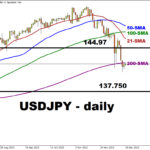The future for dividends to be paid during the remainder of 2024 by the firms that make up the S&P 500 (Index: SPX) dimmed since our previous update.This negative change in expectations took place during the past week, in the days ahead of the effective end of the second quarter of 2024 with the Friday, 21 June 2024 expiration of 2024-Q2’s dividend futures contracts. The change in outlook affects the anticipated dividend payouts for 2024-Q2, 2024-Q3, and 2024-Q4.Those changes are shown in the following animated chart tracking how the future for the S&P 500’s quarter dividends has changed since mid-October 2023. The animation presents snapshots we’ve made of that future at roughly four-to-six week intervals, with the most recent being a snapshot of the expected future for dividends taken on Monday, 24 June 2024. If you’re accessing this article on a site that republishes our RSS news feed, you may need to click through to our site to access a working version of the animated chart.animated chartThe animation captures a smaller decline between March and April 2024. That earlier dip however was not sustained and the outlook for quarterly dividends went on to generally improve during the two months that followed. Or did, up until the past week.Here are the dates of the individual snapshots presented in the animated chart, with links to where we originally presented them:
More About Dividend Futures Data
Dividend futures indicate the amount of dividends per share to be paid out over the period covered by each quarter’s dividend futures contracts, which start on the day after the preceding quarter’s dividend futures contracts expire and end on the third Friday of the month ending the indicated quarter. So for example, as determined by dividend futures contracts, the now “current” quarter of 2024-Q3 began on Saturday, 22 June 2024 and will end on Friday, 20 September 2024.That makes these figures different from the quarterly dividends per share figures reported by Standard and Poor. S&P reports the amount of dividends per share paid out during regular calendar quarters after the end of each quarter. This term mismatch accounts for the differences in dividends reported by both sources, with the biggest differences between the two typically seen in the first and fourth quarters of each year.More By This Author:S&P 500 Investors Looking For DirectionTrends For Teen Employment In May 2024S&P 500 Potentially Readies To Alter Course As US Rate Cut Expections Change








Leave A Comment